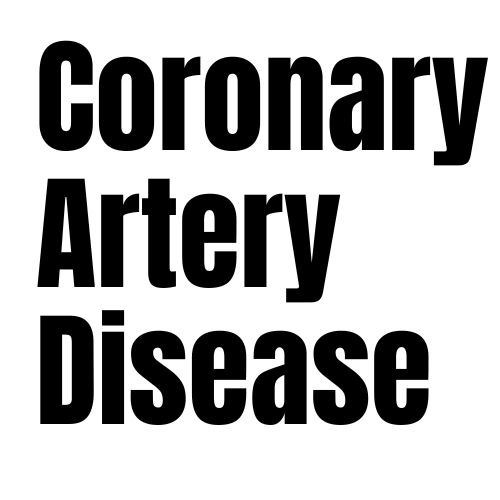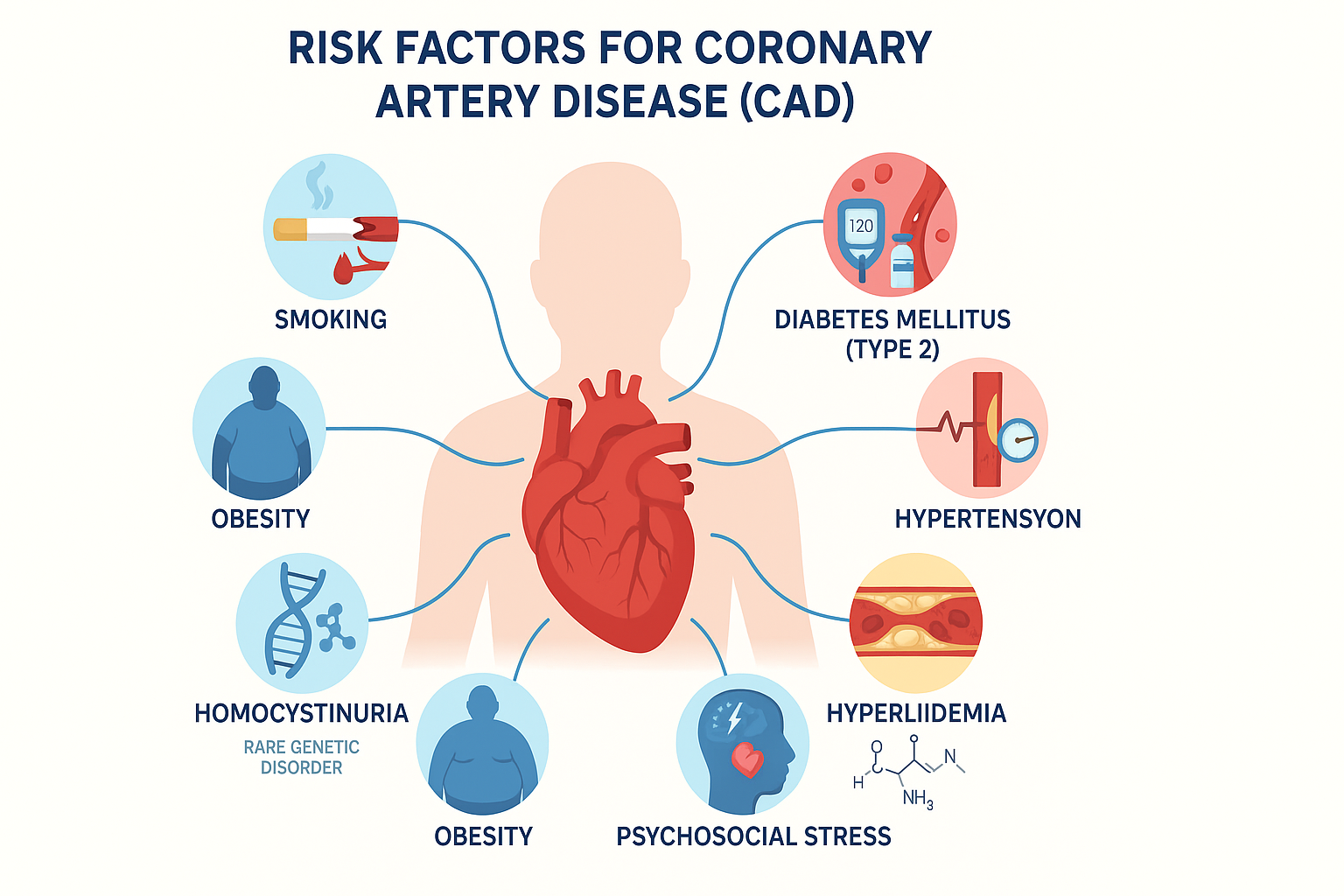Hello there! It’s important for everyone to understand What are the risk factors for Coronary Artery Disease (CAD), whether for themselves, their loved ones, or just to stay informed about heart health.
Overview
Coronary Artery Disease (CAD) is a major heart condition and a leading cause of death worldwide, affecting people in both developed and developing countries. Your risk of developing CAD is influenced by a combination of factors, including your lifestyle, environment, and genetic make-up. Being aware of these risk factors is really important because it helps in managing and potentially preventing the disease
In Details
Here’s a quick list of the major risk factors for CAD, prioritised based on their impact
- Smoking
- Diabetes Mellitus (especially Type 2 diabetes)
- Hypertension (High Blood Pressure)
- Hyperlipidemia (High Cholesterol or Fats in the Blood)
- Obesity (Excess Body Fat)
- Family History (Genetic Factors)
- Psychosocial Stress
- Homocystinuria (An inherited metabolic disorder)
- Hyperuricemia (High Uric Acid)
1. Smoking
Smoking is considered a highly significant risk factor for CAD. It is estimated to be responsible for 30–40% of annual CAD-related deaths. For smokers, the risk of dying from CAD is 70% higher compared to non-smokers. The adverse effects of cigarette smoking show a dose-response relationship, meaning the risk of CAD increases with longer duration of smoking, more cigarettes smoked, and deeper smoke inhalation. Smoking directly contributes to CAD by causing endothelial denudation (damage to the inner lining of your arteries), promoting platelet adhesion (where tiny blood cells called platelets stick together), increasing fat building up in the artery walls, and encouraging the proliferation of smooth muscle cells (cells that contribute to plaque formation).
2. Diabetes Mellitus
Diabetes, particularly Type 2 diabetes, is a significant risk factor for CAD. The risk of suffering from CAD is observed to be higher in patients with diabetes than in non-diabetics. Diabetes is often associated with hyperlipidemia, meaning you have unhealthy levels of fats in your blood. This includes increased levels of triglycerides (a type of fat) and decreased levels of HDL cholesterol (often called ‘good’ cholesterol). Low HDL cholesterol, high levels of very low-density lipoprotein (VLDL) cholesterol, and high total VLDL triglycerides have all been reported as risk factors for CAD in patients with Type 2 diabetes. These fat imbalances are central to the development of atherosclerosis.
3. Hypertension (High Blood Pressure)
There is a strong association between hypertension and CAD. Hypertension (high blood pressure) can worsen atherosclerosis. High blood pressure increases the mechanical stress on artery walls and makes their lining more permeable, allowing more fatty substances to accumulate.
4. Hyperlipidemia (High Cholesterol or Fats in the Blood)
As mentioned, hyperlipidemia is a key risk factor for CAD. It refers to having unhealthy levels of fats, such as cholesterol and triglycerides, in your blood. Low-density lipoproteins (LDL), often called ‘bad’ cholesterol, in high concentrations can permeate the damaged inner lining of blood vessels and undergo oxidation. This oxidized LDL attracts immune cells, leading to the formation of foamy cells and the earliest lesions of atherosclerosis, called a fatty streak. This process then progresses to form fibrous plaques that obstruct blood flow.
5. Obesity (Excess Body Fat)
Obesity, defined as the excess accumulation of fat in adipose tissues (fat tissues), is a common cause of cardiovascular deaths. Excess body fat, particularly around the abdominal organs (known as visceral fat), can contribute to atherosclerotic disease. It’s thought that a disruption in the balance of hormones produced by fat cells due to overnutrition may play a role in the development of atherosclerosis.
6. Family History / Genetic Factors
Family history is one of the significant risk factors for the development of CAD. Studies have shown that the heritability of CAD risk increases with a greater number of affected relatives and if the disease onset is at a young age. Certain inherited disorders, like familial hypercholesterolemia (a genetic condition causing very high cholesterol levels), are directly linked to CAD development. This indicates that your genes can make you more susceptible to CAD.
7. Psychosocial Stress
Stress has been recognized as an important and potentially modifiable risk factor for cardiovascular diseases. Various physiological changes produced by stress, such as elevated blood pressure, reduced insulin sensitivity, increased blood clotting (hemostasis), and endothelial dysfunction (when the inner lining of your blood vessels doesn’t function properly), may be relevant to cardiovascular diseases.
8. Homocystinuria
Homocystinuria is an inherited recessive disorder, or an error in metabolism. Individuals with this disorder have high levels of circulating homocysteine (a specific amino acid), and they have been found to be prone to the premature onset of cardiovascular diseases.
9. Hyperuricemia (High Uric Acid)
Hyperuricemia is generally defined as an excess of serum urate concentration in the body, specifically when serum uric acid (a product of purine metabolism) is present at a concentration more than 6.8 mg/dl. Uric acid has been found to be positively associated with arterial intima-media thickness (the thickness of the middle layer of artery wall), which is a precursor of atherosclerosis. Proposed mechanisms suggest its involvement in stimulating vascular smooth cell proliferation and reducing nitric oxide (a substance that helps blood vessels relax) production.
Other similar questions
What is the main cause of CAD?
The main cause of CAD is atherosclerosis, which is the build-up of fatty plaques in the coronary arteries, restricting blood flow to the heart. Atherosclerosis itself has a lot of risk factors.
Can lifestyle affect CAD risk?
Yes, definitely. Lifestyle, environmental factors, and genetic factors all pose as risk factors for the development of cardiovascular disease. Lifestyle choices play an important role in the development of such cardiovascular diseases. Preventive and therapeutic measures have substantially improved the prognosis of patients
Is CAD inherited?
Yes, CAD can run in families and has a genetic basis. Genome-wide association studies have suggested the association of specific chromosomal regions.
Resources
Malakar, A. K., Choudhury, D., Halder, B., Paul, P., Uddin, A., & Chakraborty, S. (2019). A review on coronary artery disease, its risk factors, and therapeutics. Journal of Cellular Physiology.



Leave a Reply